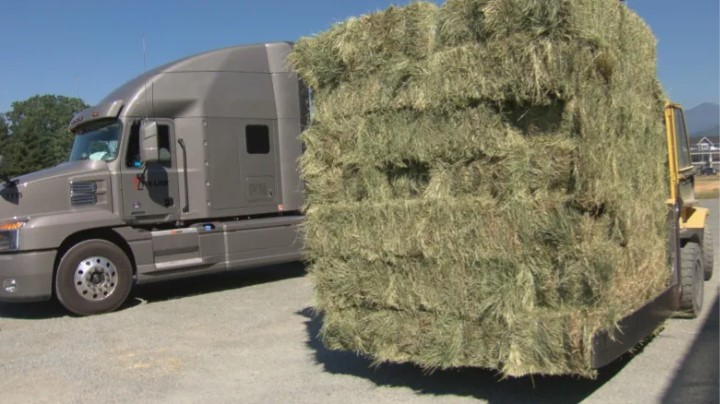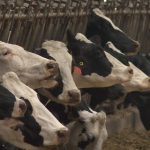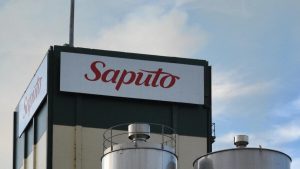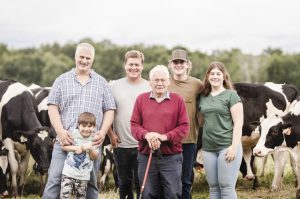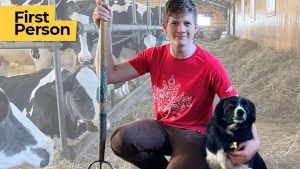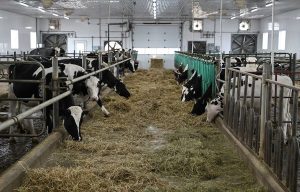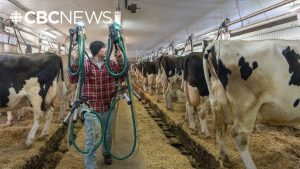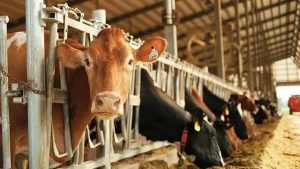
B.C. is facing a hay shortage due to a months-long drought and unseasonably hot weather patterns that are baking fields.
In the Lower Mainland, it has rained less than five times since the beginning of June, according to the weather stats website.
Both the drought and the hay shortage are being felt right across Western Canada and into some northern U.S. states — and the shortage is driving up prices and forcing ranchers to make difficult decisions about the future of their cattle.
“A lot of that grass is stunted and we’re seeing way less than we’ve ever seen,” said Steve Johnson, a partner at TNT Hay Sales, an Abbotsford, B.C.-based company that buys and sells hay.
Johnson says demand has never been higher, but there simply isn’t enough supply to keep up.
“We’re getting phone calls from Idaho, Montana. You know, places that normally put up a lot of hay for their own animals,” he said.

Normally, if one region has a bad year, other regions can make up the difference, he says. But this year’s drought is too widespread.
“Because it is so far-reaching, it’s just not going to happen and there’s no way to reverse it. And ultimately, there’s just going to be less animals around,” he said.
‘You can’t starve a cow’
It’s a tough reality facing many of B.C.’s ranchers, said Kevin Boon, general manager of the B.C. Cattlemen’s Association.
“You can’t starve a cow to death. That is not in our vocabulary. If we can’t look after them then they have to become part of the food chain,” said Boon.
“If we have to do this with our younger cattle that are highly productive, we are going to upset the chain — not only this year, but it is going to take us years to rebuild that.”
He says his association is exploring every option, including shipping hay over from the Maritimes, but it is a costly venture, one that not all ranchers can afford.
For now, he says most ranchers have enough hay saved up, but he worries how many cattle stocks will survive the winter.
Boon predicts Canada will lose about one-third of its base beef cattle herd due to the drought.
Wildfires add to the issue
As the industry scrambles to figure out how to keep cattle nourished during the drought, ranchers also have to face the reality that wildfires in B.C. are threatening what little hay crop remains.
Hundreds of fires continue to burn throughout B.C. in what is now the third most destructive wildfire season on record. As of Sunday evening, more than 8,600 square kilometres of land has been scorched — and as fires send people fleeing from their properties, livestock is sometimes left behind.
Boon says ranchers have had some of their cattle burned, while other livestock have died from smoke inhalation. Those animals that are injured, he says, must be euthanized. It’s a rancher’s worst nightmare, he adds.
“With the fires, we’re downsizing not of choice but through a disaster,” said Boon.

Dairy farms learning to adapt
While the drought and hay shortage are having a devastating effect on the beef cattle industry, dairy farms are faring a little better.
The shortage is still difficult, but dairy cow farmers often grow their hay. Some farms, like Eagle Acres Dairy Farm in Langley, B.C., were able to harvest just enough hay from their first cutting to last them the year, according to farmer Brian Anderson.
However, he normally relies on selling extra hay from the farm’s second and third cuttings, but there wasn’t enough this year.
“This year, it’s going to be tighter. We’re rationing ourselves knowing that our off-farm sales aren’t going to be as great as they have been in the past,” said Anderson.
Given the effects of climate change, Anderson says farmers are looking at planting different types of crops that can withstand drier climates.
“We’ve been seeing this for the last five to 10 years in our local Fraser Valley. Farmers are certainly looking to the future and want to make sure that we have products for our cows to eat,” he said.
As for this season — even if B.C. were to see significant rainfall now — the experts interviewed say the damage is already done.
